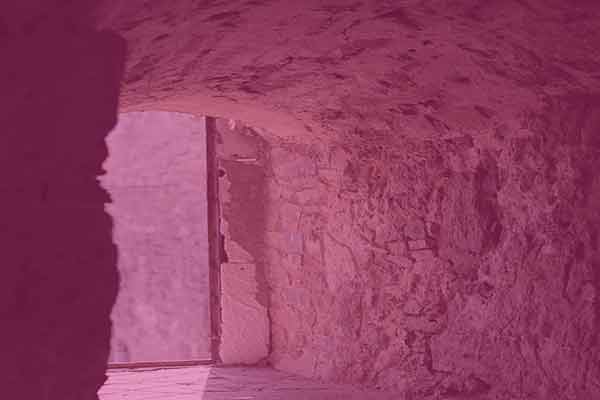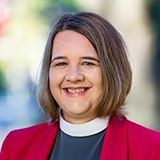by Kristen Glass Perez
In each of the four gospels, Mary Magdalene and other women are the first to arrive at the empty tomb of Jesus. They don’t expect it to be empty; they expect to prepare the body for proper burial. In this way, they show up as the people they are, ready to do what is expected of them as friends and followers of Jesus.
The fact that the women are named in each gospel is a powerful witness. It is an indicator that the women were of critical importance as witnesses to the resurrection.
Two of the gospel accounts of the resurrection have always particularly fascinated me. The first is Mark’s account. The gospel writer says:
When the Sabbath was over, Mary Magdalene, and Mary the mother of James, and Salome bought spices, so that they might go and anoint him. . . . As they entered the tomb, they saw a young man, dressed in a white robe, sitting on the right side; and they were alarmed. But he said to them, “Do not be alarmed; you are looking for Jesus of Nazareth, who was crucified. He has been raised; he is not here. Look, there is the place they laid him. But go, tell his disciples and Peter that he is going ahead of you to Galilee; there you will see him, just as he told you.” So they went out and fled from the tomb, for terror and amazement had seized them; and they said nothing to anyone, for they were afraid. (Mark 16:1-8)
At first read, this is startling. What do you mean, they said nothing to anyone? They were first-person witnesses to the resurrection! Did these women have the first recorded case of imposter syndrome?
 We don’t know what they were thinking, but I do think we can understand how they were feeling. Mary and the women had a story to tell and powerful, life-giving news to share, and yet they were afraid.
We don’t know what they were thinking, but I do think we can understand how they were feeling. Mary and the women had a story to tell and powerful, life-giving news to share, and yet they were afraid.
How many times in our lives have we each wondered how the truth that we had to share was going to be received by the world? How many times have we encountered a situation or structure that would tell us it is not OK to be who we are?
The fact is, resurrection is startling. It takes our breath away. It is the great reversal of expectations, where God makes a way where there seems to be no other way. A way to new life and new possibility. It does not make things easier, it makes them new.
That is, at first, more terrifying than calming. The account of the resurrection in Mark’s gospel feels so real to me because I know what it feels like to wonder if anybody would listen to me, and to also be shocked by something that seems impossible.
In John’s gospel, Mary’s voice is loud and clear. The gospel writer tells us:
Jesus said to her, “Mary!” She turned and said to him in Hebrew, “Rabbouni!” (which means Teacher). . . . Mary Magdalene went and announced to the disciples, “I have seen the Lord,” and she told them that he had said these things to her. (John 20: 16-18)
In this version, Jesus and Mary speak each other’s names aloud. They see each other. When Jesus speaks Mary’s name aloud, he also speaks all of our names.
He speaks into existence the startling reality of the resurrection.
Equally powerful is Mary’s naming aloud of Jesus, “Rabbouni!’ In this gospel, Mary boldly proclaims things exactly as she sees them. And what she sees is the power of the resurrection.
 The resurrection in John is also another version of the personal experience having a universal effect. Jesus does not appear to Mary on a public stage; it is in this quiet, private moment at the tomb that there is a revelation that will have universal and eternal ramifications. This is good news, for them and for us. The personal is not just political, it’s profound.
The resurrection in John is also another version of the personal experience having a universal effect. Jesus does not appear to Mary on a public stage; it is in this quiet, private moment at the tomb that there is a revelation that will have universal and eternal ramifications. This is good news, for them and for us. The personal is not just political, it’s profound.
I love these two contrasting narratives. Which one is right? Well, luckily we don’t have to make that choice. The answer is both.
We are both versions of Mary. In my own experience, I understand that there are times when I am certain of my truth, and yet I am unable to share it for fear of how it will be received.
The reasons may be personal, professional, societal, or structural. Other times, we are all public and prolific witnesses to the resurrection. In our everyday lives, we witness new relationships, new paradigms, new understandings—and we, like Mary, boldly proclaim “I too have seen the Lord.”
The Biblical narrative contains many examples of amazing women like Mary who also were often challenged for being themselves.
The good news of the gospel is that nothing can change the reality of the resurrection in which we are all qualified to be proclaimers of new life, truth and the power of possibility.
Discussion questions:
1. What do you imagine the conversation between the women might have been like as they left the empty tomb together?
2. Is there a time in your life when you were confident in your truth yet afraid of how it would be received?
3. Where have you both witnessed and proclaimed new life and resurrection?
Closing prayer
Triune God: Thank you for the ways in which you call out of us our truths. Help us to be emboldened by the women who showed up at the tomb as exactly the people you created them to be. Encourage us when we feel blocked and help us to be witnesses to the resurrection in our own daily lives. Amen.
 The Rev. Kristen Glass Perez is the campus chaplain at Muhlenberg College, Allentown, Pa.
The Rev. Kristen Glass Perez is the campus chaplain at Muhlenberg College, Allentown, Pa.

